Hailegiorgis Biramo Allaro
College of Agriculture and Environmental Science, School of Agricultural Economics and Agribusiness Management, Haramaya University, Ethiopia
Correspondence to: Hailegiorgis Biramo Allaro , College of Agriculture and Environmental Science, School of Agricultural Economics and Agribusiness Management, Haramaya University, Ethiopia.
| Email: |  |
Copyright © 2012 Scientific & Academic Publishing. All Rights Reserved.
Abstract
This research examines export performance of oilseeds and its determinants in Ethiopia using macroeconomic time series data from annual reports of NBE (National Bank of Ethiopia) over the period 1974 to 2009. Analyses of oilseeds export performance through time divulges that the country has not yet diversified the commodity composition and structure of its export, in that its export earnings depend on only a few agricultural products. The findings of the study reveal that the country needs to break away from it’s heavily depends on traditional export commodities for which it is a marginal exporter, thus a price taker. The results also show that the estimated coefficients of real output (Ry) and nominal exchange rate (e) are statistically significant. This discloses that real output and nominal exchange rate have positive brunt on the export performance of oilseeds in Ethiopia.
Keywords:
Africa, Ethiopia, Export Performance, Oilseeds
Cite this paper:
Hailegiorgis Biramo Allaro , "Export Performance of Oilseeds and ITS Determinants in Ethiopia", American Journal of Economics, Vol. 1 No. 1, 2011, pp. 1-14. doi: 10.5923/j.economics.20110101.01.
1. Introduction
Nations’ of the world differ in their resource endowments and level of technology applied in the production of goods and services. The engagement of nations in the international trade depends upon a nation’s specialisation in the production of goods in which they have comparative advantages constructs room for improvement of the welfare of the society as a whole. This theory traces back to the last half of the 18th century, the time when Adam Smith realized the importance of specialization and trade in his Wealth of Nations. Subsequently many economists advocated the contribution of international trade for welfare of nations (as the engine of growth) in the overall process of economic development (Onafowora and Owoye, 1998 and Arndt, 1999). The international trade of SSA (Sub-Saharan African) countries are mainly based on exporting primary agricultural commodities in which they have comparative advantages due to cheap labor and tropical climate. In the context of Ethiopia, coffee alone constitutes more than 50 percent of the total agricultural export of the country. Accordingly, different studies show that diversifying the export sector towards non-traditional agricultural commodities is crucial to attain stability in export earnings of a country (Alwang and Siegel, 1994). Agriculture is the mainstay of the Ethiopian economy. Its share accounts for more than 40% of the total GDP, 50% of foreign currency earnings and above 80 % of employment creation. Both industry and services are dependent on the performance of agriculture, which provides raw materials, generates foreign currency for the import of essential inputs and food for the fast growing population. In spite of its importance in the national economy, agriculture is based on subsistence farm households, whose modes of life and operation have remained unchanged for centuries. The objective of this study is to scrutinise oilseeds export performance and its determinants in Ethiopia with the application of adopted Goldstein and Khan (1985) imperfect substitution model and annual macroeconomic time series data from the annual reports of NBE for the period 1974 to 2009. However, as results of this study reveal, despite this research attempt in examining the export performance of oilseeds and its determinants in Ethiopia, there has been no study conducted on export performance of oilseeds and its determinants in the country. The basis for the analyses is to validate empirically the hypothesis that exports from Ethiopia is rising since the reform was launched. The manuscript is organised as follows: section 2 present a brief review of world oilseeds production and marketing. Section 3 demonstrate domestic use, import and export of oilseeds in Ethiopia, section 4 display oilseeds export performance and its determinants in Ethiopia, section 5 explains Ethiopian opportunities for specialty oilseeds, section 6 develops the model to be estimated, and in section 7 the empirical analyses is undertaken. Section 8 conclusions.
2. World Oilseeds production and marketing
The worldwide major oilseeds are: Soybean, rapeseed, cottonseed, safflower seed, groundnut, palm, copra, Sesame, Castro seed, maize oil and coconut oil. The major producers of oilseeds are USA, China, Brazil, India, Malaysia, Indonesia, EU-15 Countries, Central Europe, Canada, and Argentina. According to FAO database the world oilseeds production is 449 million tons for 2010. Ethiopia has altitudes from below sea level up to more than 4,500m above sea level with very different climates. This enables Ethiopia to grow a wide range of oilseeds, in which it has a long tradition. Oilseeds are the second largest export earner for the country after coffee in which more than 3 million smallholders are involved in its production. Exports actually consist of sesame and Niger seed, for which there is a growing demand in the world market. Ethiopia ranks among the top 5 world producers of sesame seed and linseed. It is also an important producer of Niger seed. Castoro, linseed and safflower have good export potential. The growing demand in the world market for these specialty products and the available capacity to expand production could make oilseeds turn into one of the engines of economic growth of Ethiopia. Groundnuts, safflower, rapeseed and many other oilseeds are produced on a limited scale. The main production regions of sesame seed are Tigray, Amhara, Oromia and Benshangul Gumuzi (Bennet, 2004).
3. Domestic use, import and export of oilseeds in Ethiopia
Sesame seed is the main oilseed export product. Niger seed, as second, is exported mainly to the US as bird seed. In 2005 and 2006 Ethiopian exports further increased, whereby China came up as a new market. Export of sesame seed has grown in double digits each year from 1998 to 2006:50,000 tons in 1998 and more than 100,000 tons in 2006.In the second half of 2006 the main export markets for Ethiopian sesame seed were China, Israel and other countries in the Middle East and Turkey. The EU had a market share of 8% (CSA, 2006). The major importers of Ethiopian sesame seed in the EU are Greece, Germany, the Netherlands and the UK. Japan is the biggest world importer of sesame seed. Sesame oil, particularly from roasted seed, is an important component of Japanese cooking. Traditionally this is the principal use of the seed. Japanese are very critical of quality. Because of quality problems in the past, Ethiopia is not an important exporter for Japan. However, it seems that via China the volume of Ethiopian oilseeds exported to Japan is increasing. All other oilseed crops (soybeans, groundnuts, cottonseed etc.) grown in Ethiopia are almost entirely used domestically. Reliable figures of domestic use are not available. Most of the oil is consumed as crude oil. Ethiopia is a net importer of refined oil, mainly refined soybean and palm oil. Palm oil is mainly imported from Malaysia, Singapore and the United Arab Emirates. Italy is the major supplier (75 percent) of soybean oil, followed by Turkey 10 percent (FAO, 2008, USAD, 2008, 2009, 2010, 2011).
4. oilseeds Export performance and its determinants in Ethiopia
Export performance is the relative success or failure of the efforts of a firm or nation to sell domestically produced goods and services in other nations. Export performance can be described in objective terms such as sales, profits, or marketing measures or by subjective measures such as distributor or customer satisfaction. Determinants of export performance can be split into external and internal components. External components include market access/entry conditions and a country’s location vis a vis international markets. Internal components are related to supply-side conditions. Foreign demand is influenced by various elements. Firstly, it is strongly linked to geography (the structural component). Typically, countries at the center of a fast growing region are more likely to benefit than countries situated outside that region. Second, it is likely to be related to competition and trade policy (the market access/entry component), which could have, in principle, a similar impact on trade than geography. Finally, both the quantity and quality of physical infrastructures (the development component) are expected to play important roles (Lages, et al., 2004).Trade policy is always controversial in its impact on the overall economy. Advocates of free trade believe all nations benefit from eliminating import tariffs, quotas, and export subsidies. The Ethiopian government has been moving toward a freer trade policy ever since the liberalization. New trade agreements for agricultural commodities and other manufactured goods have reduced tariffs and quotas in the last 10 years. As a consequence, the most competitive and productive sectors of the economy benefit the most from a liberalized trade policy. Access to foreign markets is a critical determinant of export performance. It relates directly to the characteristics of the trading partner countries, such as the size of their market and transport facilities, and inversely to their own internal transport costs. It also depends positively on the size of the export basket and the number of differentiated items and their prices, which in turn are affected by market entry conditions. Transborder costs, which also include tariff and non-tariff barriers, have the expected negative impact on foreign market access (Anderson, 2004, Fugazza, 2004).Despite the worldwide fall in trade barriers that has occurred in the last two decades, export performance has varied substantially across countries. World exports increased almost 220 percent in twenty years. The figure jumps to 720 percent for East Asian and Pacific countries and falls to 80 percent for Sub-Saharan countries. The exports of “best performers”, such as the Republic of Korea, China, Cambodia and Vietnam, have grown by more than 15 percent annually over the whole period. “Worst performers”, mostly African and Latin American countries, have negative annual growth rate records in at least one decade. As a result of various trade negotiations and autonomous reforms, access to international markets has improved in the last twenty years. Nonetheless, it is likely that there is still much to gain from further improvements in market access conditions. Concerns have also been raised about the necessity to improve supply conditions. Supply conditions are fundamental in defining the export potential of an economy. For a given level of access to international markets, countries with better supply conditions are expected to export more (Maskus, 2003).Recently Redding and Venables (2004) investigated the relative contribution towards export performance of international linkages relative to internal geographical factors. They found that most of the differential in export performance of various countries and over the last three decades can be due to differences in the evolution of external components. Nevertheless, they found that internal components related to supply capacity such as internal geography and institutional quality also have played a significant role in explaining the observed differential in export performance. Accounting for unobservable heterogeneity should allow the identification of any differences in the effect of and importance of export performance components, which are linked to the degree of development of the external sector itself. In other words, the techniques used here allow for the testing for non-linearities in the relationship between export performance and its components. While dynamic panel techniques would seem to be the most desirable approach, data availability is likely to restrict their implementation. In this context, cross-sectional analysis proves to be a viable alternative. Regression techniques which are able to account for unobserved heterogeneity across countries, namely quantile regressions, are used. Moreover, more emphasis is put on the determination and impact assessment of variables related to supply conditions. This is done with the aim of determining as clearly as possible what are policy implications. The study revealed important differences across countries and regions when looking at their respective determinants of export performance. External and internal components prove to have played an equal role in determining export performance for Asian countries. Their improvement in the South East and Pacific region appears to be high relative to that observed in any other region. Sub - Saharan African countries owe their export performance to the evolution of external components. The latter were strong enough to more than offset a relative deterioration of their internal production conditions. Further investigation also indicates that good internal conditions are necessary to obtain good export performance. Particular attention should be paid to the macroeconomic dimension. Good infrastructures and non-stringent institutions are also necessary to put the export sector on a durable development path. In addition, there is scope for promoting a dynamic process of diversification across and within sectors. Constant efforts to support diversification are particularly relevant for commodities exporters’ when a secular downward trend is observed in volatile commodities prices (Maskus, 2003, Redding and Venables, 2004).
5. Ethiopian opportunities for specialty oilseeds
Most oilseed crops -soybeans, cotton seed, rapeseed etc. - grown in Ethiopia are also grown in many other countries in large volumes. For these oilseed crops, it will be very difficult for Ethiopia to compete on the world market due to its relatively low volumes and high handling and transport costs. The Ethiopian production for these crops is mostly less than 0.1%of the world production. To achieve a beneficial market position on the world market huge efforts are required, which will be out of scope for Ethiopia in the near future. These crops, however, can be of high importance for the domestic market, as food crop. Most potential for the Ethiopian oilseeds sector concerns the following specialty Oilseeds: sesame seed, safflower seed, linseed, Niger seed and castor beans (Abate, T.; 2006a and 2006b).
6. The Method
The study was persistence on secondary data sources. When a close look was made at the time-series estimates of Ethiopia's major macroeconomic variables, it shows that different sources report different values for the same variables. In order to avert this problem and ensure the consistency as well as comparatively of results annually published time- series data were extracted from the published annual reports of the NBE (National Bank of Ethiopia). Annual data were favoured to the purpose of precision for most of the variables. Long term data are not available for the variable considered in the study in the case of Ethiopia. The ideal national account data available to undertake time series based studies is from 1963 onwards which still lack accuracy.
6.1. Data Coverage
The study covers 36 years, from 1974 to 2009. Review of the different publications of the NBE (Annual Reports and Quarterly Bulletins) reveals that data are available on the export earnings, price (unit values), and quantities of major export commodities since 1963. As the latest available data on the external trade of the country are 2009, the last year of study period.
6.2. Definitions of Export performance
A conceptual definition of export performance addresses two parts: export and performance. Export is the international marketing related decisions and activities of internationally active firms (Cavugil and Neviv, 1981). The overtone of the word performance, in the literature sense, does not pose any problem for it is the act of carrying out or accomplishing something such as a task or action. When it comes to economics, this word has been defined in many ways and no unifying principle has underlined its quantification.However, in the context of current study, Export performance is defined as:(i) the success or failure of the efforts of a nation to sell domestically produced goods and services in other nations markets (Zou and stan, 1998);(ii) the export effectiveness, export efficiency and continuous engagement in exporting (Shoham, 1991);(iii) the composite outcome a nation’s international sales (Shoham, 1996); and(iv) the three sub-dimensions which encompasses sales, profit and growth (Madsen, 1987).
6.3. Model specification
The study signifies export performance of oilseeds in Ethiopia as a function of domestic price, world price, real output and nominal exchange rate. The analysis is expressed with the adopted Goldstein and Khan (1985) imperfect substitution model expressed as follows: | (1) |
Where, OlsXP refers oilseeds export performance; pd, domestic price; pw , world price; Ry, real out put and e, nominal exchange rate. At estimation stage taking logs of the variables in equation (1) and differentiating with respect to time gives the trend of exports as: | (2) |
where, ’s are unknown parameters to be estimated, t is time in years (1974-2009) and
’s are unknown parameters to be estimated, t is time in years (1974-2009) and  is random terms that are independently and identically distributed with mean zero and variance2 (δ2). To estimate equation (2) the time-series approach was applied. The empirical results were tested using Eviews 3 and SPSS 15.
is random terms that are independently and identically distributed with mean zero and variance2 (δ2). To estimate equation (2) the time-series approach was applied. The empirical results were tested using Eviews 3 and SPSS 15.
7. Results and Discussion
The classical linear regression model (CLRM) and ECM (error correction model) are used to estimate the data. Prior to running the estimation, model diagnostic tests and corrections are made. These include heteroscedasticity, autocorrelation, multicollinearity and non stationary in the data. In order to detect heteroscedasticity, a plot of OLS residuals against the dependant variable ( ) is made. Although the model passes ANOVA test, plot of OLS residuals against time and formal test to detect autocorrelation using partial autocorrelation function (PACF) are done (Annex Figure 1-4). The estimation begins with the testing of variables for unit roots to determine whether they can be considered as a stationary or non-stationary process. Table 1 presents the Augmented Dickey Fuller (ADF) tests of variables. The tests showed that all the variables were non-stationary at level. The variables were stationary at second difference. Critical values for tests were found to be –3. 55 and –3.21 at 5% and 10% respectively. Annex Table 1(a-e) gives details of unit root test outputs of variables. To examine whether the integrated variables are cointegrated, it was modelled using variables to achieve stationarity which leads to loss of long-run information. The concept of cointegration implies that if there is a long-run relationship between two or more non-stationary variables, deviations from this long-run path are stationary. Johansen’s cointegration multivariate procedure is used to establish whether the variables are cointegrated in the long run. As result, the likelihood ratio indicates one co-integrating equations at 5% significance level. In other words, it accepts alternative hypothesis of having one co-integrating vector. Since the test statistic (85.18) is greater than the 95% critical value (68.52) of the likelihood ratio test, it is possible to reject the null of more than one co-integrating vector (Annex Table 2). The maximum Eigen value test starts with the null hypothesis of at most r co-integrating vector against the alternative of r+1. The result for maximum Eigen value test confirms the rejection of the null hypothesis; i.e., no co-integrated vectors. Therefore, both maximum Eigen value and likelihood ratio indicate that there is one co-integrating equations at 5% significance levels (Table 2).
) is made. Although the model passes ANOVA test, plot of OLS residuals against time and formal test to detect autocorrelation using partial autocorrelation function (PACF) are done (Annex Figure 1-4). The estimation begins with the testing of variables for unit roots to determine whether they can be considered as a stationary or non-stationary process. Table 1 presents the Augmented Dickey Fuller (ADF) tests of variables. The tests showed that all the variables were non-stationary at level. The variables were stationary at second difference. Critical values for tests were found to be –3. 55 and –3.21 at 5% and 10% respectively. Annex Table 1(a-e) gives details of unit root test outputs of variables. To examine whether the integrated variables are cointegrated, it was modelled using variables to achieve stationarity which leads to loss of long-run information. The concept of cointegration implies that if there is a long-run relationship between two or more non-stationary variables, deviations from this long-run path are stationary. Johansen’s cointegration multivariate procedure is used to establish whether the variables are cointegrated in the long run. As result, the likelihood ratio indicates one co-integrating equations at 5% significance level. In other words, it accepts alternative hypothesis of having one co-integrating vector. Since the test statistic (85.18) is greater than the 95% critical value (68.52) of the likelihood ratio test, it is possible to reject the null of more than one co-integrating vector (Annex Table 2). The maximum Eigen value test starts with the null hypothesis of at most r co-integrating vector against the alternative of r+1. The result for maximum Eigen value test confirms the rejection of the null hypothesis; i.e., no co-integrated vectors. Therefore, both maximum Eigen value and likelihood ratio indicate that there is one co-integrating equations at 5% significance levels (Table 2). Table 1. ADF unit root tests.
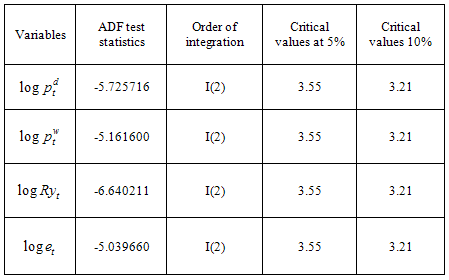 |
| |
|
Table 2. Co-integration tests for logrxt,logpdt, logpwt, logryt and loget.
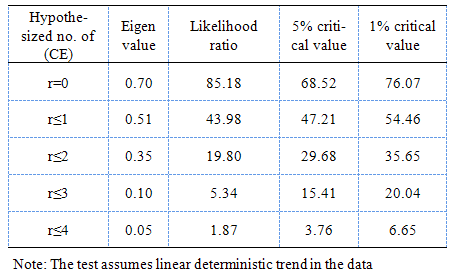 |
| |
|
After identifying the co-integrating equation, unit root test carried for the equation indicates that the equation is integrated of order AR I (2). Furthermore, unit root test with intercept shows that the equations pass’s ADF test (Annex Table 3).Then equation entered into the final ECM estimation model (Annex Table 4). The equation is:ECT=logpdt-0.997538*LOGPWT-0.000323*LOGRYT-1.003508*LOGET +0.004729Estimation is done for the equation using ECM. The results indicate that  and
and  are significant and positive while others were insignificant. The significance of real output and nominal exchange rate highlight that these variables as the imperative factors of oilseeds export performance. Thus, 0.2678 and 2.004 of
are significant and positive while others were insignificant. The significance of real output and nominal exchange rate highlight that these variables as the imperative factors of oilseeds export performance. Thus, 0.2678 and 2.004 of  and
and  respectively indicate the short run impact of real output and nominal exchange rate which implies that in the short run real output and nominal exchange rate cause export growth of oilseeds. Although, other variables are insignificant that can’t explain explicitly the short run impact on export performance. The long runs estimates suggest that logpwt, logryt and loget are positively related to
respectively indicate the short run impact of real output and nominal exchange rate which implies that in the short run real output and nominal exchange rate cause export growth of oilseeds. Although, other variables are insignificant that can’t explain explicitly the short run impact on export performance. The long runs estimates suggest that logpwt, logryt and loget are positively related to  while logpdt negatively. The insignificance of error correction term (ECT) shows that this variable is exogenous in the given model. Since all the variables are in their logarithmic form, it is possible to attach a suppleness meaning to the coefficients. Consequently, a percentage change in
while logpdt negatively. The insignificance of error correction term (ECT) shows that this variable is exogenous in the given model. Since all the variables are in their logarithmic form, it is possible to attach a suppleness meaning to the coefficients. Consequently, a percentage change in ,
,  and
and  are associated with 0.7811, 0.2678 and 2.004 in the same direction with
are associated with 0.7811, 0.2678 and 2.004 in the same direction with , while
, while  is associated with 0.0051 in different direction with. The result of R2 is 0.56 (56%) which reveals that 56% of Ethiopian oilseeds export performance is caused by real output and nominal exchange rate, while 44% is by other variables which were not included in the model. Furthermore, F-statistic is significant which implies that the model:
is associated with 0.0051 in different direction with. The result of R2 is 0.56 (56%) which reveals that 56% of Ethiopian oilseeds export performance is caused by real output and nominal exchange rate, while 44% is by other variables which were not included in the model. Furthermore, F-statistic is significant which implies that the model:  is fit (Table 3).
is fit (Table 3). Table 3. estimations results using ECM.
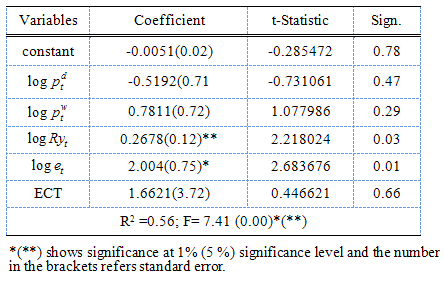 |
| |
|
The constant ( 0= 4.041) states that there are others variables that were not comprised in the model to explainexport performance. The estimators of
0= 4.041) states that there are others variables that were not comprised in the model to explainexport performance. The estimators of  (1=-0.803),
(1=-0.803),  (
( 2=1.205),
2=1.205),  (
( 3=0.350) and
3=0.350) and  (
( 4=1.899) signify that
4=1.899) signify that positively and significantly explain oilseeds export performance of Ethiopian, while
positively and significantly explain oilseeds export performance of Ethiopian, while  negatively (Table 4).
negatively (Table 4).Table 4. Coefficient diagnosis.
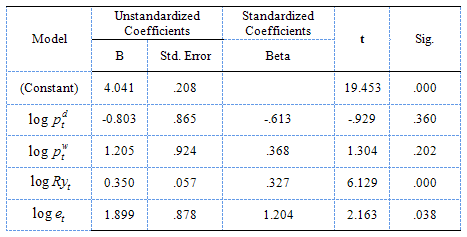 |
| |
|
8. Conclusions
This paper has evaluated the magnitude of trends of oilseeds export performance in Ethiopia over the period 1974 to 2009. This study investigates empirically the trends of export performance by analysing prices (domestic and world), real output and nominal exchange rate. The evidence from this study suggests that real output and nominal exchange rate significantly influence oilseeds export performance. It was also revealed that during the reform period oilseeds export has shown improvement. It was inferred that oilseeds export performance demands an appropriate macroeconomic incentive environment and complementary structural policies. Thus, Ethiopia’s oilseeds export performance will be determined primarily by its domestic policies. It was scrutinised that despite the generally open trade regime, industrial countries tend to have restrictions on imports of agricultural products, where much of Ethiopia’s export potential is concentrated. Further, it is argued that a country's oilseeds export may fail to grow as rapidly as the world average for three reasons. First, exports may be concentrated in commodity groups for which demand tends to grow relatively at a low rate. Second, export may be going mainly to relatively stagnant regions/blocs. Third, the country in question may have been unwilling or unable to compete effectively with other sources of supply in the international market. For this purpose, exports from rest of the world are treated as competitor to Ethiopia. Therefore; regional trading arrangements (within Africa) should be set to put in economic efficiency, trade, investment, and growth in the region.
ACKNOWLEDGEMENTS
I am gratefully acknowledged the constructive comments and suggestions of anonomous reviewers. Annex | Table 1(a). ADF test on logOLSXPt at 2nd difference with intercept and trend. |
| | ADF Test Statistic | -5.312820 | 1% Critical Value* | -4.2712 | | | | 5% Critical Value | -3.5562 | | | | 10% Critical Value | -3.2109 | | *MacKinnon critical values for rejection of hypothesis of a unit root. | | Augmented Dickey-Fuller Test Equation | | Dependent Variable: D(LOGolsxpt,3) | | Method: Least Squares | | Date: 08/16/10 Time: 16:06 | | Sample(adjusted): 1978 2009 | | Included observations: 32 after adjusting endpoints | | Variable | Coefficient | Std. Error | t-Statistic | Prob. | | D(LOGolsxpt(-1),2) | -1.737246 | 0.326991 | -5.312820 | 0.0000 | | D(LOGolsxpt(-1),3) | 0.124239 | 0.185909 | 0.668278 | 0.5094 | | C | -0.009994 | 0.065868 | -0.151728 | 0.8805 | | @TREND(1974) | 0.000539 | 0.003053 | 0.176690 | 0.8610 | | R-squared | 0.775552 | Mean dependent var | -0.002500 | | Adjusted R-squared | 0.751504 | S.D. dependent var | 0.319778 | | S.E. of regression | 0.159407 | Akaike info criterion | -0.718237 | | Sum squared resid | 0.711501 | Schwarz criterion | -0.535020 | | Log likelihood | 15.49180 | F-statistic | 32.25012 | | Durbin-Watson stat | 2.045163 | Prob(F-statistic) | 0.000000 |
|
|
| Table 1(b). ADF unit root test on logpdt at 2nd difference with intercept and trend. |
| | ADF Test Statistic | -5.725716 | 1% Critical Value* | -4.2712 | | | | 5% Critical Value | -3.5562 | | | | 10% Critical Value | -3.2109 | | *MacKinnon critical values for rejection of hypothesis of a unit root. | | Augmented Dickey-Fuller Test Equation | | Dependent Variable: D(LOGPDT,3) | | Method: Least Squares | | Date: 08/15/10 Time: 15:25 | | Sample(adjusted): 1978 2009 | | Included observations: 32 after adjusting endpoints | | Variable | Coefficient | Std. Error | t-Statistic | Prob. | | D(LOGPDT(-1),2) | -2.032778 | 0.355026 | -5.725716 | 0.0000 | | D(LOGPDT(-1),3) | 0.131845 | 0.187279 | 0.704001 | 0.4872 | | C | -0.045336 | 0.053502 | -0.847370 | 0.4040 | | @TREND(1974) | 0.002026 | 0.002476 | 0.818522 | 0.4200 | | R-squared | 0.899852 | Mean dependent var | 0.001250 | | Adjusted R-squared | 0.889122 | S.D. dependent var | 0.383984 | | S.E. of regression | 0.127861 | Akaike info criterion | -1.159285 | | Sum squared resid | 0.457753 | Schwarz criterion | -0.976068 | | Log likelihood | 22.54856 | F-statistic | 83.86183 | | Durbin-Watson stat | 2.055184 | Prob(F-statistic) | 0.000000 |
|
|
| Table 1(c). ADF unit root test on logpwt at 2nd difference with intercept and trend. |
| | ADF Test Statistic | -5.161600 | 1% Critical Value* | -4.2712 | | | | 5% Critical Value | -3.5562 | | | | 10% Critical Value | -3.2109 | | *MacKinnon critical values for rejection of hypothesis of a unit root. | | Augmented Dickey-Fuller Test Equation | | Dependent Variable: D(LOGPWT,3) | | Method: Least Squares | | Date: 08/15/10 Time: 15:27 | | Sample(adjusted): 1978 2009 | | Included observations: 32 after adjusting endpoints | | Variable | Coefficient | Std. Error | t-Statistic | Prob. | | D(LOGPWT(-1),2) | -1.779718 | 0.344800 | -5.161600 | 0.0000 | | D(LOGPWT(-1),3) | 0.069771 | 0.188261 | 0.370606 | 0.7137 | | C | -0.035330 | 0.060499 | -0.583971 | 0.5639 | | @TREND(1974) | 0.001322 | 0.002803 | 0.471408 | 0.6410 | | R-squared | 0.826963 | Mean dependent var | -0.003125 | | Adjusted R-squared | 0.808424 | S.D. dependent var | 0.332551 | | S.E. of regression | 0.145555 | Akaike info criterion | -0.900050 | | Sum squared resid | 0.593219 | Schwarz criterion | -0.716833 | | Log likelihood | 18.40080 | F-statistic | 44.60516 | | Durbin-Watson stat | 2.036182 | Prob(F-statistic) | 0.000000 |
|
|
| Table 1(d). ADF unit root test on logryt at 2nd difference with intercept and trend. |
| | ADF Test Statistic | -6.640211 | 1% Critical Value* | -4.2712 | | | | 5% Critical Value | -3.5562 | | | | 10% Critical Value | -3.2109 | | *MacKinnon critical values for rejection of hypothesis of a unit root. | | Augmented Dickey-Fuller Test Equation | | Dependent Variable: D(LOGRYT,3) | | Method: Least Squares | | Date: 08/16/10 Time: 19:12 | | Sample(adjusted): 1978 2009 | | Included observations: 32 after adjusting endpoints | | Variable | Coefficient | Std. Error | t-Statistic | Prob. | | D(LOGRYT(-1),2) | -2.020305 | 0.304253 | -6.640211 | 0.0000 | | D(LOGRYT(-1),3) | 0.375854 | 0.177677 | 2.115378 | 0.0434 | | C | -0.000636 | 0.064040 | -0.009929 | 0.9921 | | @TREND(1974) | 0.000126 | 0.002970 | 0.042288 | 0.9666 | | R-squared | 0.766518 | Mean dependent var | -0.007187 | | Adjusted R-squared | 0.741502 | S.D. dependent var | 0.304909 | | S.E. of regression | 0.155024 | Akaike info criterion | -0.774007 | | Sum squared resid | 0.672907 | Schwarz criterion | -0.590790 | | Log likelihood | 16.38411 | F-statistic | 30.64115 | | Durbin-Watson stat | 2.059745 | Prob(F-statistic) | 0.000000 |
|
|
| Table 1(e). ADF test on loget at 2nd difference with intercept and trend. |
| | ADF Test Statistic | -5.039660 | 1% Critical Value* | -4.2712 | | | | 5% Critical Value | -3.5562 | | | | 10% Critical Value | -3.2109 | | *MacKinnon critical values for rejection of hypothesis of a unit root. | | Augmented Dickey-Fuller Test Equation | | Dependent Variable: D(LOGET,3) | | Method: Least Squares | | Date: 08/24/10 Time: 22:23 | | Sample(adjusted): 1978 2009 | | Included observations: 32 after adjusting endpoints | | Variable | Coefficient | Std. Error | t-Statistic | Prob. | | D(LOGET(-1),2) | -1.531692 | 0.303928 | -5.039660 | 0.0000 | | D(LOGET(-1),3) | 0.235216 | 0.191938 | 1.225478 | 0.2306 | | C | -0.004046 | 0.028623 | -0.141346 | 0.8886 | | @TREND(1974) | 0.000430 | 0.001327 | 0.324168 | 0.7482 | | R-squared | 0.623785 | Mean dependent var | 0.003125 | | Adjusted R-squared | 0.583476 | S.D. dependent var | 0.107296 | | S.E. of regression | 0.069248 | Akaike info criterion | -2.385787 | | Sum squared resid | 0.134267 | Schwarz criterion | -2.202570 | | Log likelihood | 42.17260 | F-statistic | 15.47516 | | Durbin-Watson stat | 2.041389 | Prob(F-statistic) | 0.000004 |
|
|
Table 2. Johansen cointergration test on logolsxpt, logpdt, logpwt, logryt and logret.
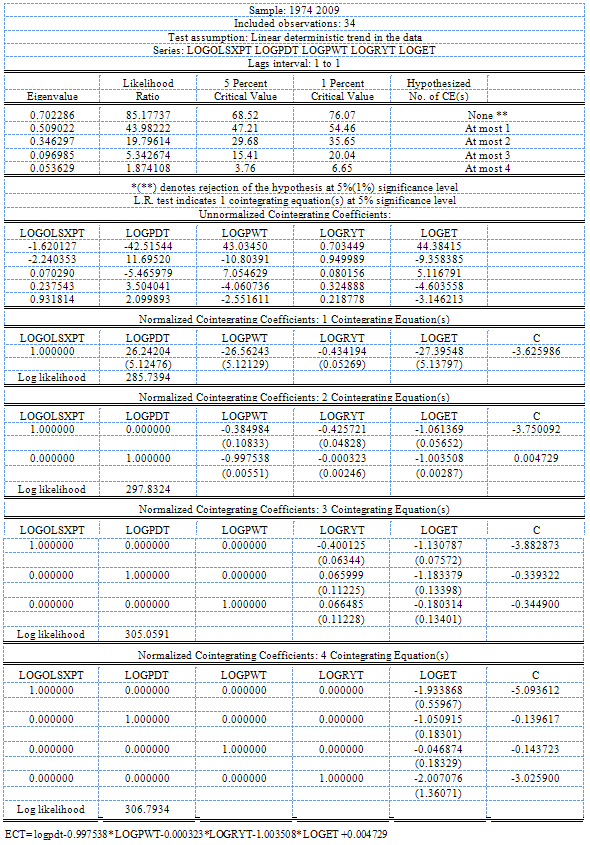 |
| |
|
| Table 3. ADF test on ECT at level with intercept |
| | ADF Test Statistic | -7.115321 | 1% Critical Value* | -3.6353 | | | | 5% Critical Value | -2.9499 | | | | 10% Critical Value | -2.6133 | | *MacKinnon critical values for rejection of hypothesis of a unit root. | | Augmented Dickey-Fuller Test Equation | | Dependent Variable: D(ECT3) | | Method: Least Squares | | Date: 08/24/10 Time: 21:44 | | Sample(adjusted): 1976 2009 | | Included observations: 34 after adjusting endpoints | | Variable | Coefficient | Std. Error | t-Statistic | Prob. | | ECT3(-1) | -1.282956 | 0.180309 | -7.115321 | 0.0000 | | D(ECT3(-1)) | 0.035629 | 0.034403 | 1.035641 | 0.3084 | | C | -0.000194 | 0.000763 | -0.253940 | 0.8012 | | R-squared | 0.627061 | Mean dependent var | -6.89E-05 | | Adjusted R-squared | 0.603001 | S.D. dependent var | 0.006973 | | S.E. of regression | 0.004393 | Akaike info criterion | -7.933344 | | Sum squared resid | 0.000598 | Schwarz criterion | -7.798665 | | Log likelihood | 137.8668 | F-statistic | 26.06180 | | Durbin-Watson stat | 2.029297 | Prob(F-statistic) | 0.000000 |
|
|
| Table 4. Equation estimation with ECM. |
| | Dependent Variable: D(LOGRXT) | | Method: Least Squares | | Date: 08/24/10 Time: 21:52 | | Sample(adjusted): 1975 2009 | | Included observations: 35 after adjusting endpoints | | D(LOGOLSXPT)= C(1)+ C(2)*D(LOGPDT)+C(3)*D(LOGPWT)+C(4) | | *D(LOGRYT)+C(5)*D(LOGET) +C(6)*ECT3 | | | Coefficient | Std. Error | t-Statistic | Prob. | | C(1) | -0.005071 | 0.017762 | -0.285472 | 0.7773 | | C(2) | -0.519185 | 0.710181 | -0.731061 | 0.4706 | | C(3) | 0.781067 | 0.724561 | 1.077986 | 0.2899 | | C(4) | 0.267825 | 0.120749 | 2.218024 | 0.0345 | | C(5) | 2.004283 | 0.746842 | 2.683676 | 0.0119 | | C(6) | 1.662131 | 3.721573 | 0.446621 | 0.6585 | | R-squared | 0.560853 | Mean dependent var | 0.040857 | | Adjusted R-squared | 0.485139 | S.D. dependent var | 0.126011 | | S.E. of regression | 0.090417 | Akaike info criterion | -1.813955 | | Sum squared resid | 0.237084 | Schwarz criterion | -1.547324 | | Log likelihood | 37.74421 | F-statistic | 7.407438 | | Durbin-Watson stat | 1.970283 | Prob(F-statistic) | 0.000140 |
|
|
Table 5. Area, yield, production and export of oilseeds in Ethiopia (1974-2009).
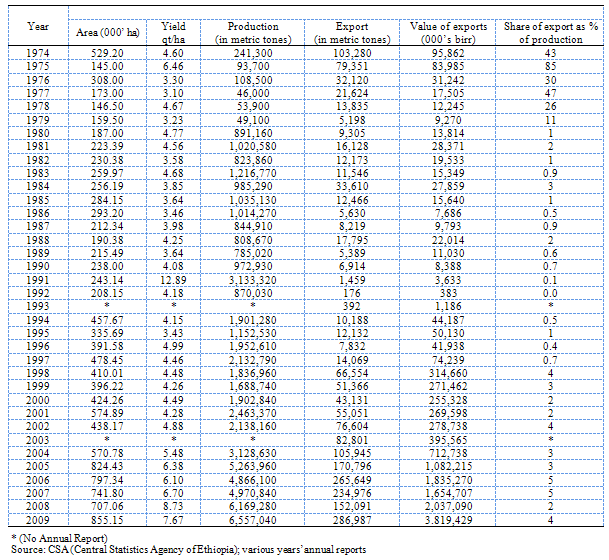 |
| |
|
Table 6. Percentage share of oilseeds export value in total values of exports (1974-2009).
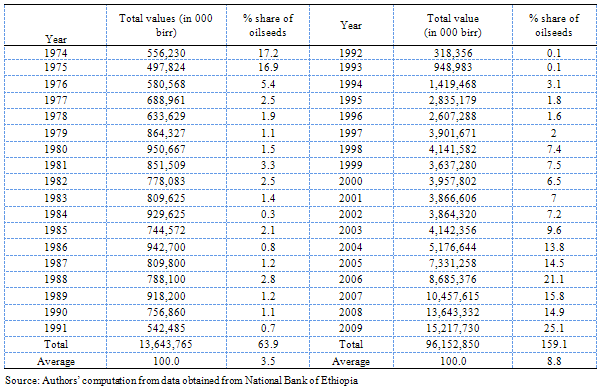 |
| |
|
Table 7. List of Ethiopian oilseeds and pulses exporters.
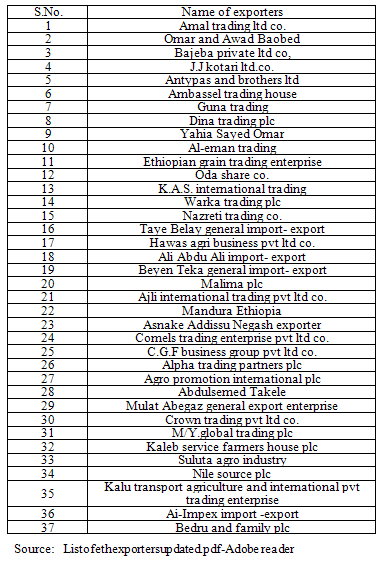 |
| |
|
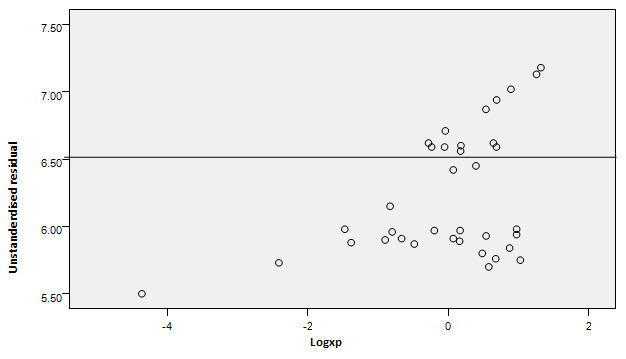 | Figure 1. Heteroscedasticity diagnosis. |
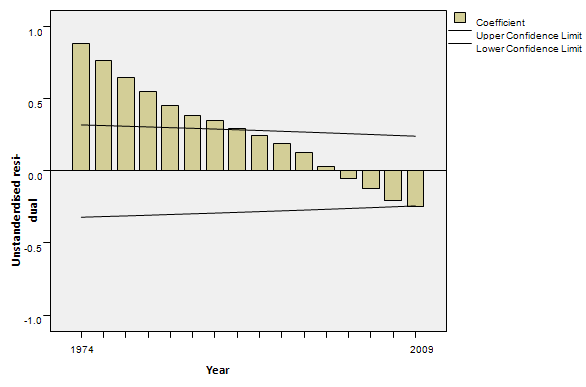 | Figure 2. Autocorrelation diagnosis. |
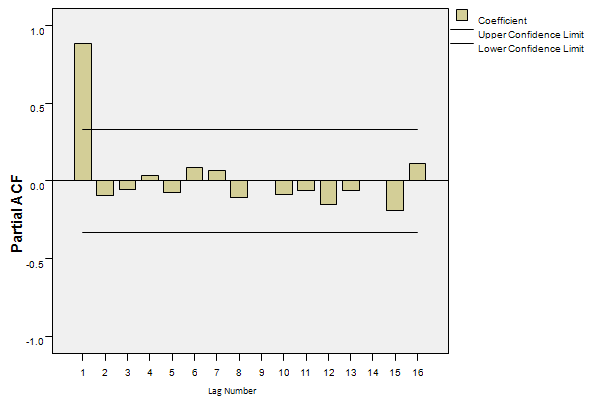 | Figure 3. Partial Autocorrelation (before correction). |
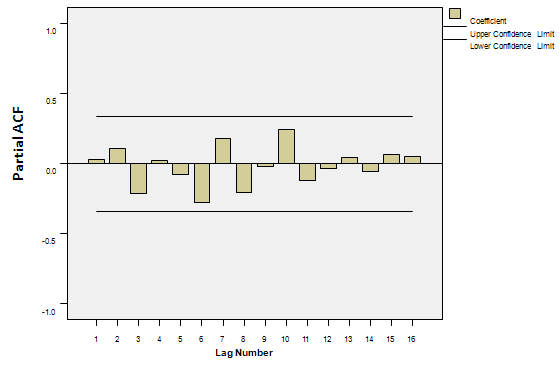 | Figure 4. Partial autocorrelation function (after autocorrelation problem corrected). |
Notes
1ANOVA-Analysis of Variance
References
| [1] | Abate, T., editor, 2006a.Succesives with value chain. Ethiopian institution of Agricultural Research, Addis Ababa |
| [2] | Abate, T., editor, 2006b.Focusinge Agricultural Research to Address Development Needs; the way I see it. In Abate, T.2006a. P1-20 |
| [3] | Alwang, J. and P.B. Siegel, 1994. Portfolio Models and Planning for Export Diversification: Malawi, Tanzania and Zimbabwe, Journal of Development Studies, 30(2): 405-422 |
| [4] | Anderson K, 2004. Agriculture Trade Reform and Poverty Reduction: Implications for Sub-Saharan Africa. UNCTAD Policy Issues in International Trade and Commodities No. 22 |
| [5] | Arndt, S. W.,1999. Globalization and Economic Development. The Journal of International Trade and Economic Development 8(3): 309-318 |
| [6] | Bennet, M., 2004. Sesame. In; Salvin. S., M. Bourke and T. Byrne, 2004. The new crop industries handbook. Australian Government, RIRDC publication04/125. P214-220 |
| [7] | CSA (Central Statistical Agency of Federal Democratic Republic of Ethiopia), 2006. Annual report. |
| [8] | FAO (Food and Agricultural Organization), 2010. Food outlook |
| [9] | Fugazza, M., 2004. Export Performance and its Determinants: Supply and Demand Constraints. UNCTAD Policy Issues in International Trade and Commodities No. 26 |
| [10] | Goldstein, M., and M. Khan. 1985. “Income and Price Effects in Foreign Trade.” In R. Jones and P. Kenen, eds., Handbook of International Economics 2. Amsterdam: Elsevier |
| [11] | Lages, Luis Filipe & Cristiana Raquel Lages.2004. "The STEP scale: A measure of short-term export performance improvement." Journal of International Marketing, 12(1), 36-56 |
| [12] | Madsen, T., 1987. Empirical export performance studies: a review of conceptualizations and findings. In S. T. Cavusgil (Ed.). Advances in international marketing, Vol. 2:177-198. Greenwich, CT: JAI Press Inc |
| [13] | Maksus, K. E., 2003, Comment on Redding and Venables (2003), in Challenges to Globalization: Analyzing the Economics, R. E. Baldwin and A. L Winters, eds., The University of Chicago Press |
| [14] | Onafowora, O. A., and O. Owoye, 1998. Can trade liberalization Stimulate Economic growth in Africa? World Development, 26(3): 497-506 |
| [15] | Redding S. and A. Venables, 2004. “Geography and Export Performance: External Market Access and Internal Supply Capacity”, Chapter 3, in (eds) Baldwin, R and Winters, A, Challenges to Globalization: Analyzing the Economics, CEPR-NBER conference volume, NBER and Chicago University Press |
| [16] | Shoham, A., 1996. Export performance: a conceptualization and empirical assessment. Journal of International Marketing, 6(3), 59-81 |
| [17] | Shoham, A., 1991. The impact of marketing strategies, marketing research, and marketing planning on the export performance of Brazilian exporters |
| [18] | USDA (Unites States Department of Agriculture): Foreign Agricultural Service, 2008-2011. Oilseeds: World Market and Trade Archives |
| [19] | Zou, S. and Stan, S., 1998. “The Determinants of Export Performance: A Review of the Empirical Literature Between 1987 and 1997”, International Marketing Review, Volume 15(5), 333-356 |



 ’s are unknown parameters to be estimated, t is time in years (1974-2009) and
’s are unknown parameters to be estimated, t is time in years (1974-2009) and  is random terms that are independently and identically distributed with mean zero and variance2 (δ2). To estimate equation (2) the time-series approach was applied. The empirical results were tested using Eviews 3 and SPSS 15.
is random terms that are independently and identically distributed with mean zero and variance2 (δ2). To estimate equation (2) the time-series approach was applied. The empirical results were tested using Eviews 3 and SPSS 15.  ) is made. Although the model passes ANOVA test, plot of OLS residuals against time and formal test to detect autocorrelation using partial autocorrelation function (PACF) are done (Annex Figure 1-4). The estimation begins with the testing of variables for unit roots to determine whether they can be considered as a stationary or non-stationary process. Table 1 presents the Augmented Dickey Fuller (ADF) tests of variables. The tests showed that all the variables were non-stationary at level. The variables were stationary at second difference. Critical values for tests were found to be –3. 55 and –3.21 at 5% and 10% respectively. Annex Table 1(a-e) gives details of unit root test outputs of variables. To examine whether the integrated variables are cointegrated, it was modelled using variables to achieve stationarity which leads to loss of long-run information. The concept of cointegration implies that if there is a long-run relationship between two or more non-stationary variables, deviations from this long-run path are stationary. Johansen’s cointegration multivariate procedure is used to establish whether the variables are cointegrated in the long run. As result, the likelihood ratio indicates one co-integrating equations at 5% significance level. In other words, it accepts alternative hypothesis of having one co-integrating vector. Since the test statistic (85.18) is greater than the 95% critical value (68.52) of the likelihood ratio test, it is possible to reject the null of more than one co-integrating vector (Annex Table 2). The maximum Eigen value test starts with the null hypothesis of at most r co-integrating vector against the alternative of r+1. The result for maximum Eigen value test confirms the rejection of the null hypothesis; i.e., no co-integrated vectors. Therefore, both maximum Eigen value and likelihood ratio indicate that there is one co-integrating equations at 5% significance levels (Table 2).
) is made. Although the model passes ANOVA test, plot of OLS residuals against time and formal test to detect autocorrelation using partial autocorrelation function (PACF) are done (Annex Figure 1-4). The estimation begins with the testing of variables for unit roots to determine whether they can be considered as a stationary or non-stationary process. Table 1 presents the Augmented Dickey Fuller (ADF) tests of variables. The tests showed that all the variables were non-stationary at level. The variables were stationary at second difference. Critical values for tests were found to be –3. 55 and –3.21 at 5% and 10% respectively. Annex Table 1(a-e) gives details of unit root test outputs of variables. To examine whether the integrated variables are cointegrated, it was modelled using variables to achieve stationarity which leads to loss of long-run information. The concept of cointegration implies that if there is a long-run relationship between two or more non-stationary variables, deviations from this long-run path are stationary. Johansen’s cointegration multivariate procedure is used to establish whether the variables are cointegrated in the long run. As result, the likelihood ratio indicates one co-integrating equations at 5% significance level. In other words, it accepts alternative hypothesis of having one co-integrating vector. Since the test statistic (85.18) is greater than the 95% critical value (68.52) of the likelihood ratio test, it is possible to reject the null of more than one co-integrating vector (Annex Table 2). The maximum Eigen value test starts with the null hypothesis of at most r co-integrating vector against the alternative of r+1. The result for maximum Eigen value test confirms the rejection of the null hypothesis; i.e., no co-integrated vectors. Therefore, both maximum Eigen value and likelihood ratio indicate that there is one co-integrating equations at 5% significance levels (Table 2).  and
and  are significant and positive while others were insignificant. The significance of real output and nominal exchange rate highlight that these variables as the imperative factors of oilseeds export performance. Thus, 0.2678 and 2.004 of
are significant and positive while others were insignificant. The significance of real output and nominal exchange rate highlight that these variables as the imperative factors of oilseeds export performance. Thus, 0.2678 and 2.004 of  and
and  respectively indicate the short run impact of real output and nominal exchange rate which implies that in the short run real output and nominal exchange rate cause export growth of oilseeds. Although, other variables are insignificant that can’t explain explicitly the short run impact on export performance. The long runs estimates suggest that logpwt, logryt and loget are positively related to
respectively indicate the short run impact of real output and nominal exchange rate which implies that in the short run real output and nominal exchange rate cause export growth of oilseeds. Although, other variables are insignificant that can’t explain explicitly the short run impact on export performance. The long runs estimates suggest that logpwt, logryt and loget are positively related to  while logpdt negatively. The insignificance of error correction term (ECT) shows that this variable is exogenous in the given model. Since all the variables are in their logarithmic form, it is possible to attach a suppleness meaning to the coefficients. Consequently, a percentage change in
while logpdt negatively. The insignificance of error correction term (ECT) shows that this variable is exogenous in the given model. Since all the variables are in their logarithmic form, it is possible to attach a suppleness meaning to the coefficients. Consequently, a percentage change in ,
,  and
and  are associated with 0.7811, 0.2678 and 2.004 in the same direction with
are associated with 0.7811, 0.2678 and 2.004 in the same direction with , while
, while  is associated with 0.0051 in different direction with. The result of R2 is 0.56 (56%) which reveals that 56% of Ethiopian oilseeds export performance is caused by real output and nominal exchange rate, while 44% is by other variables which were not included in the model. Furthermore, F-statistic is significant which implies that the model:
is associated with 0.0051 in different direction with. The result of R2 is 0.56 (56%) which reveals that 56% of Ethiopian oilseeds export performance is caused by real output and nominal exchange rate, while 44% is by other variables which were not included in the model. Furthermore, F-statistic is significant which implies that the model:  is fit (Table 3).
is fit (Table 3).  0= 4.041) states that there are others variables that were not comprised in the model to explainexport performance. The estimators of
0= 4.041) states that there are others variables that were not comprised in the model to explainexport performance. The estimators of  (1=-0.803),
(1=-0.803),  (
( 2=1.205),
2=1.205),  (
( 3=0.350) and
3=0.350) and  (
( 4=1.899) signify that
4=1.899) signify that positively and significantly explain oilseeds export performance of Ethiopian, while
positively and significantly explain oilseeds export performance of Ethiopian, while  negatively (Table 4).
negatively (Table 4).



 Abstract
Abstract Reference
Reference Full-Text PDF
Full-Text PDF Full-Text HTML
Full-Text HTML






